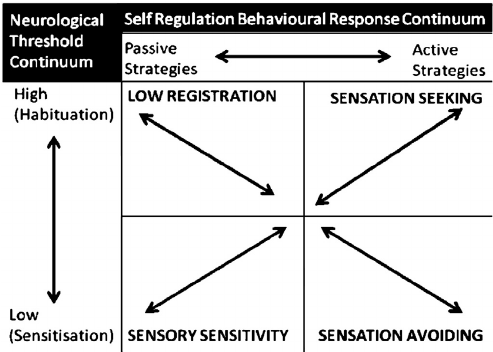Sensory processing is the ability to organise and interpret information received through the senses. There are 5 commonly known senses – taste, vision, touch, smell and sound. There are also 2 lesser- known sensory systems – the proprioceptive system and the vestibular system. The proprioceptive system receives information from muscles, joints and tendons and the vestibular system receives information regarding the body’s position in space, for example balance.
We all have different neurological thresholds for each sensory input. A neurological threshold is the amount of sensory stimuli required for a neuron or neuron system to respond. It can be helpful to think of neurological thresholds as cups – some of us have big cups and some of us have small cups. In other words, some people needs lots of sensory input while others don’t need much at all. When a person’s cup is full, they will have a behavioural response. These can either be active or passive. Using auditory input as an example a person’s cup may become full in a very loud room, an active behavioural response would be to leave the room, while a passive response would be to continue to sit in the room. People with passive behavioural responses can often become dysregulated as their cups can often overflow with sensory input.
There are 4 sensory processing quadrants in which all people land:
Low registration
People in the low registration quadrant have high neurological thresholds (big cups). They also display passive behavioural responses. They can often miss sensory information that other people pick up on. An example of this might be a child who doesn’t smell things that other people say they smell.
Sensation Seeking
People in the sensory seeking quadrant again have high neurological thresholds. Different to people in the low registration quadrant though they have active behavioural responses. Due to their high threshold, they are often seeking input to ‘fill their cup.’ Examples of children who are sensory seeking include children who are very active or children who add spice to their food.
Sensory Sensitive
People in the sensory sensitive quadrant have low neurological thresholds (small cups). Like people in the low registration quadrant, they also have passive behavioural strategies. Children who are sensory sensitive often continually detect sensory input and may often hear or smell things that other people can’t.
Sensory Avoiding
People in the sensory avoiding quadrant have low neurological thresholds and active behavioural responses. It does not take much to fill their cup up and when it is they will often withdraw from the situation. Children within this quadrant often withdraw from overwhelming sensory input and may only eat familiar foods.
Will Liebing – Occupational Therapist
Image source: Ciro, Carrie. “Dunn’s Model of Sensory Processing”. MedBridge. 2022. https://www.medbridgeeducation.com/course-catalog/details/dementia-therapists-guide-to-behavioral-management/



